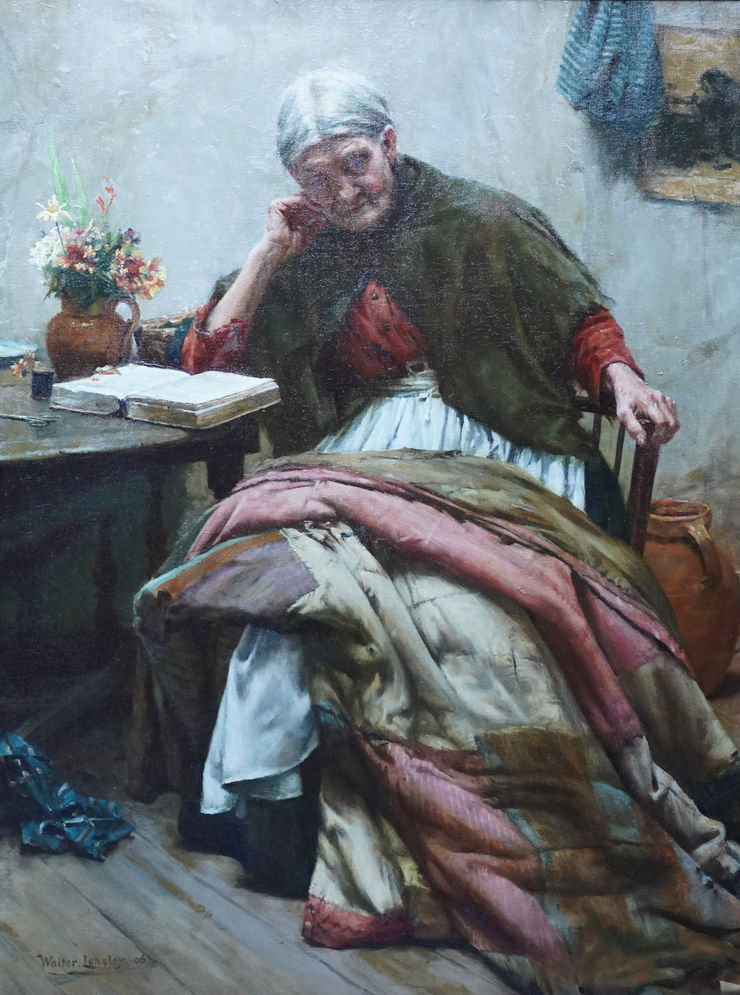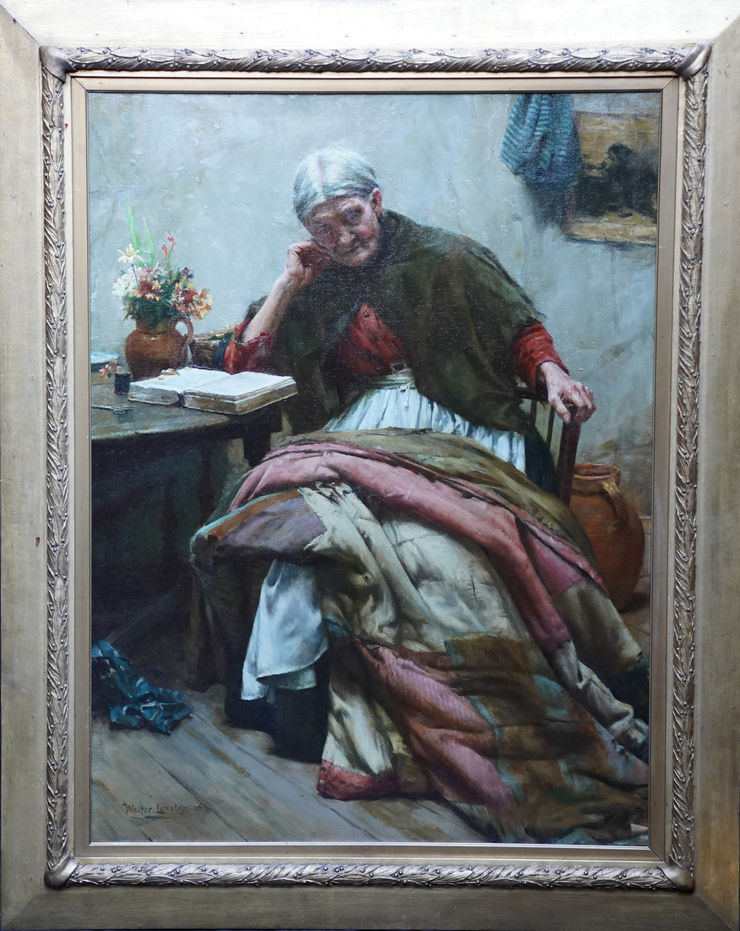Walter Langley (1852-1922)
| Artist Name | Walter Langley (1852-1922) |
|---|---|
| Title | The Evening of Life - Interior Portrait |
| Description | This stunning, large British Edwardian Newlyn School interior portrait oil painting is by much noted and exhibited artist Walter Langley. Originally from Birmingham, Langley and his family moved to St Ives in 1881. He was one of the first artists to settle and painted the local fishermen and their families. Painted in 1906 and entitled The Evening of Life, the painting is a full length seated portrait of an elderly lady in a cottage interior. She is sat by a table on which she has a bible, jug of flowers and her sewing equipment. Across her lap she has a large patchwork quilt to mend but is lost in thought. In fact the same sitter and quilt can be seen in Memories, also painted in 1906 and in the Ferens Art Gallery, Hull. Memories includes more of the cottage interior but the sitter's head is bowed towards her hands. The Evening of Life is more vibrant and the sitters face is much more visible as are the lovely colours of the quilt. The painting has fantastic detail, great brushwork and the Newlyn school palette of colours. The provenance is excellent, having been kept in the same family ownership so fresh to market. The painting appeared in the artist's catalogue Raisonne and was also in 1997 biography by Langely's grandson, Roger Langley, entitled Walter Langley: Pioneer of the Newlyn Art Colony. This a superb example of Langley's work, a good size and composition and a pleasure to gaze upon. Signed lower left and dated (19)06. |
| Provenance | Ford, 1906 (£63). Long in the previous family ownership and sold by the executors of the estate. Thomas Wood and Sons label vereso. Literature: Langley (R) - Walter Langley Pioneer of the Newlyn Art Colony 1997, catalogue raisonne p.170 (under 1906). |
| Medium | Oil on Canvas |
| Size | 30 x 40 inches |
| Frame | Housed in a gilt frame 47 inches by 37 inches and in good condition. |
| Condition | Good condition. |
| Biography | Walter Langley (8 June 1852 – 21 March 1922) was an English painter and founder of the Newlyn School of plein air artists.He was born in Birmingham and his father was a journeyman tailor. At 15 he was apprenticed to a lithographer. At 21 he won a scholarship to South Kensington and he studied designing there for two years. The sometimes highly ornate work is mainly in gold and silver and in a Renaissance style. He returned to Birmingham but took up painting full-time, and in 1881 was elected an Associate of the Royal Birmingham Society of Artists. In the same year he was offered £500 for a year's work by a Mr Thrupp (a Birmingham photographer). With this money he and his family moved to Newlyn where he was one of the first artists to settle and began recording the life of the fishing community. Politically left wing for his era, he was noted for his social realist portrayals of working class figures, particularly fishermen and their families. He was a supporter of Charles Bradlaugh, a radical socialist politician. His own working-class background enabled him to identify with the villagers and the hardships they endured, many of his paintings reflect this sympathy with the working-class fisher-folk amongst whom he lived. One of the best known works is the watercolour For Men Must Work and Women Must Weep (1883; Birmingham Museum and Art Gallery) based on Charles Kingsley's poem The Three Fishers (1851). Another is Between The Tides (1901; Warrington Museum & Art Gallery). Although one of the first to settle in the Newlyn artists' colony Newlyn School, Langley initially benefited little from its growing fame, partly because of his working-class origins and partly because until 1892 he painted largely in watercolour rather than the more prestigious medium of oils. His early training in lithography gives his paintings a detail and texture that show his technical skills. In 1884, Langley was elected a member of the RBSA and continued to exhibit widely throughout the UK and abroad. Later in his career his reputation grew. One of Langley's paintings was singled out as "a beautiful and true work of art" by Leo Tolstoy in his book What is Art?, while in 1895 Langley was invited by the Uffizi to contribute a self-portrait to hang alongside those of Raphael, Rubens and Rembrandt in their collection of portraits of great artists. Today his work is considered "vital to the image of the Newlyn School" and "alongside Stanhope Forbes ... the most consistent in style and substantial in output". Exhibited: Royal Society of Artist Birmingham 57, Dudley Gallery 4, Dowdeswell Gallery 17, Fine Art Society 72, Glasgow Institute 10, Walker Gallery Liverpool 26, Leicester Gallery 2, Manchester City Gallery 9, Royal Academy 30, Royal Society of British Artists 3, Royal Hibernian Society 1, Royal Institute of Painters in Water Colours 80, Royal Institute of Oil Painters 8, Royal Scottish Society of Painters in Water Colours 2. |
| Price | £47000 |

